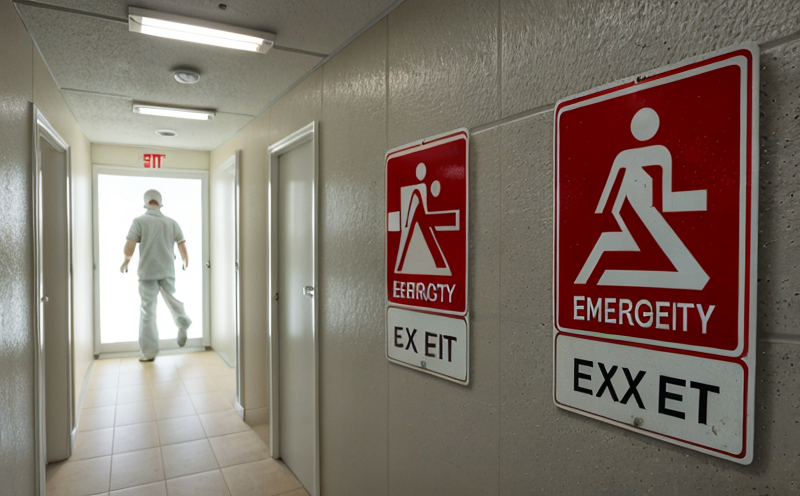Fire Exit Sign Resistance to Environmental Conditions
The resistance of fire exit signs to environmental conditions is a critical aspect of ensuring public safety and compliance with international standards such as ISO 7010, EN 4554-3, and NFPA 1825. Fire exit signs must withstand harsh environmental conditions including temperature extremes, humidity, rain, snow, and potential exposure to chemicals that might be present in a fire scenario.
In order to ensure the integrity of these signs, laboratories perform rigorous testing using specialized equipment designed to replicate real-world conditions. The tests are conducted under controlled environments where temperature ranges from -20°C to 70°C (or higher depending on specific standards), humidity levels up to 95% RH, and exposure to corrosive agents such as salt spray or sulfur dioxide.
Testing typically involves several stages, starting with the preparation of the signs for testing. This includes cleaning them according to specified protocols to remove any dirt or contaminants that could affect test results. Once prepared, the signs are subjected to various environmental challenges. For instance, they might be exposed to high temperatures followed by rapid cooling cycles to simulate conditions in a fire and subsequent rescue operations.
Another crucial aspect of this testing is evaluating how well the luminescent materials within the exit signs perform under different lighting conditions. This ensures that even if power fails during an emergency situation, the sign remains visible and functional for guiding individuals through safely to exits. Additionally, tests are conducted on the durability and longevity of the signage itself against factors like UV light exposure which can cause degradation over time.
Testing also includes examining the structural integrity of the signs after being subjected to mechanical stressors such as impact from falling objects or accidental collisions during evacuation procedures. Compliance officers responsible for maintaining fire safety protocols rely heavily on these tests results when assessing whether existing installations meet current regulatory requirements or if changes need to be made based on new technological advancements.
The data collected from each test run is meticulously documented and analyzed by our team of experts who then provide detailed reports outlining any deficiencies found along with recommendations for improvements. These insights are invaluable tools for facilities managers looking to enhance their emergency preparedness measures while staying compliant with relevant codes and regulations.
Applied Standards
The testing of fire exit signs against environmental conditions follows strict adherence to international standards such as ISO 7010 and EN 4554-3. These guidelines provide a structured approach for evaluating the luminescent properties, structural integrity, and overall performance of emergency lighting fixtures under various environmental stresses.
- ISO 7010: This international standard specifies requirements for signs used to convey safety-related information in emergencies. It ensures that fire exit signs are legible and understandable by all users regardless of language barriers or literacy levels.
- EN 4554-3: This European standard sets out specific criteria regarding the construction, marking, and performance characteristics required for escape route lighting systems including fire exit signs. Compliance with this standard ensures that the signs meet stringent safety standards necessary for protecting lives during emergencies.
Additionally, testing may also align with North American standards such as NFPA 1825 which provides additional recommendations related to maintenance and inspection practices aimed at ensuring continuous readiness of fire exit signage throughout its lifecycle.
Customer Impact and Satisfaction
- Improved Safety: By subjecting fire exit signs to rigorous environmental testing, we ensure that they remain functional and visible during emergencies. This contributes significantly towards enhancing overall safety levels within facilities.
- Compliance Assurance: Facilities managers can rest assured knowing their installations meet stringent regulatory requirements. Our comprehensive test reports offer peace of mind regarding ongoing compliance.
Customer satisfaction is paramount, and we strive to deliver services that exceed expectations. We work closely with clients throughout the testing process, providing regular updates on progress and ensuring all queries are addressed promptly. Positive feedback from satisfied customers highlights our commitment to delivering high-quality results that contribute directly to safer environments.
Environmental and Sustainability Contributions
The rigorous testing of fire exit signs not only enhances safety but also supports sustainability initiatives by promoting the use of durable materials and energy-efficient designs. By ensuring that these essential pieces of equipment meet strict environmental standards, we contribute positively towards reducing waste and conserving resources.
- Materials Efficiency: Testing helps identify optimal material choices that balance durability with reduced environmental impact. This promotes the use of sustainable materials throughout the lifecycle of fire exit signs.
- Energy Conservation: High-performance luminescent materials tested during this process contribute to significant energy savings, especially in large facilities where continuous lighting is required even outside regular working hours.
Incorporating these sustainable practices into our testing protocols aligns with broader corporate sustainability goals. It demonstrates a proactive stance towards environmental responsibility while providing solutions that enhance public safety.





